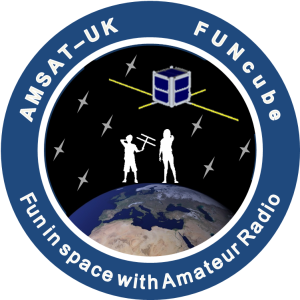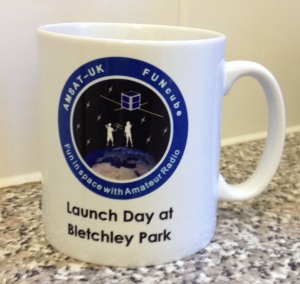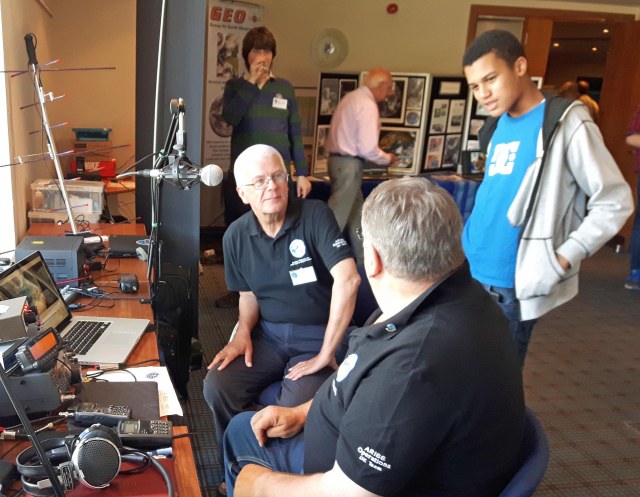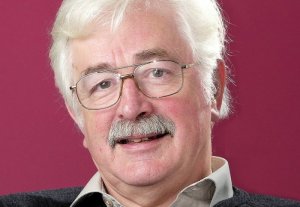
AMSAT-UK FUNcube Mission Patch
In space, satellites can be found. A recent development in this area are the “CubeSat” satellites.
Normal satellites typically have a size ranging from that of a washing machine to a small truck.
CubeSats have the size of a milk-carton!
The JOTA-JOTI FUNcube Challenge focuses on the FUNcube-1 (AO-73) CubeSat satellite. During the Jamboree On The Air (JOTA-JOTI) on October 19-21, a special, coded, message will be transmitted. This message can be received with a simple 2m handheld antenna, e.g. HB9CV, a small yagi or even a vertical, and a SDR-dongle or any SSB radio for 2m. The data is sent by the satellite on its telemetry channel of 145.935 MHz (1200bd BPSK modulated). You will need to set your receiver to Upper Side Band (USB). If you use a FUNcube dongle, you can directly receive the satellite.
The message is coded using the Enigma cipher machine. The deciphering key and Enigma settings can be obtained by answering the questions below.
The message sent by the satellite follows the following format: JOTA JOTI START coded message STOP
Your deciphered message can be mailed to: JJ.Satellite.Challenge (at) kitbuilding.org ( (at)=@)
The mail should contain your name, age, country and Scout group name and the correct answer!

AO-73 (FUNcube-1) – Image credit Wouter Weggelaar PA3WEG
If you have any pictures of the reception of the satellite with your group, this would also be highly appreciated, we would love to see how you did it!
If your answer is right and mailed before the 1st of November 2018, you will participate in a raffle.
The winner will get some products from www.kitbuilding.org
Have a lot of fun and good luck! Best 73s, Wouter PA3WEG and Jeroen PE1RGE
Information about the FUNcube1 can be found at:
https://funcube.org.uk/
https://www.amsat.org/two-way-satellites/ao-73-funcube-1/
https://en.wikipedia.org/wiki/FUNcube-1
Possible online Enigma coding machines:
http://users.telenet.be/d.rijmenants/en/enigmasim.htm
https://people.physik.hu-berlin.de/~palloks/js/enigma/enigma-i+m3_v16.html
Background information on the Enigma can be found here:
http://www.cryptomuseum.com/crypto/enigma/
The message is coded with an Enigma M3, Navy version. Plugboard (Steckerbrett) is not used!!

FUNcube-1 Launch Day Mug
The questions for obtaining the deciphering key:
1.) A geostationary satellite has an altitude above the earths surface of (approximately):
A. 20200 km or 12600 miles – First rotor is rotor III
B. 35786 km or 22236 miles – First rotor is rotor V
C. 42164 km or 26199 miles – First rotor is rotor VII
2.) NASA has selected over 300 astronauts since 1959,
A. None of them was ever active in Scouting – First rotor alphabet setting (ringstellung) A
B. Not more than 37 of them were active in Scouting – First rotor alphabet setting
(ringstellung) F
C. More than 200 were/are active in Scouting – First rotor alphabet setting (ringstellung) S
3.) The average distance between the moon and the earth is:
A. 1738 km or 1080 miles – First rotor initial setting (grundstellung) D
B. 12742 km or 7918 miles – First rotor initial setting (grundstellung) G
C. 385001 km or 239228 miles – First rotor initial setting (grundstellung) H
4.) AMSAT, an organisation involved in launching a number of radio amateur satellites was founded in:
A. 1969 – Second rotor is rotor II
B. 1978 – Second rotor is rotor VI
C. 1991 – Second rotor is rotor VIII
5.) As satellites are flying extremely high in the sky, at least 100 Watts of transmit power is needed to establish communication with or through a satellite. Is this true or false?
A. True – Second rotor alphabet setting (ringstellung) D
B. False – Second rotor alphabet setting (ringstellung) C
6.) The Russian Sputnik 1 was the first artificial satellite orbiting around the earth. When was this satellite launched?
A. October 4th, 1957 – Second rotor initial setting (grundstellung) A
B. January 31st, 1958 – Second rotor initial setting (grundstellung) G
C. July 20th, 1969 – Second rotor initial setting (grundstellung) F
7.) The abbreviation OSCAR means:
A. Open Source Communication for Amateur Radio – Third rotor is rotor III
B. Outer Space Charge – free Amateur Radio – Third rotor is rotor IV
C. Orbiting Satellite Carrying Amateur Radio – Third rotor is rotor I
8.) Signals from a satellite are characterized by Doppler-shift, this means:
A. The frequency of the transmitted signal appears to be higher when the satellite is moving towards you. – Third rotor alphabet setting (ringstellung) T
B. The frequency of the transmitted signal appears to be lower when the satellite is moving towards you. – Third rotor alphabet setting (ringstellung) U
9.) If a radio amateur wants to communicate through satellites he/she needs to do an additional exam in order to obtain a special license, the Amateur Radio Operator License (AROL). True or false?
A. True – Third rotor initial setting (grundstellung) R
B. False – Third rotor initial setting (grundstellung) M
10.) Radio amateurs can make radio contact with the ISS (International Space Station)?
A. Yes – Reflector B
B. No – Reflector C
Download PDF of the JOTA-JOTI 2018_FUNcube_Challenge









